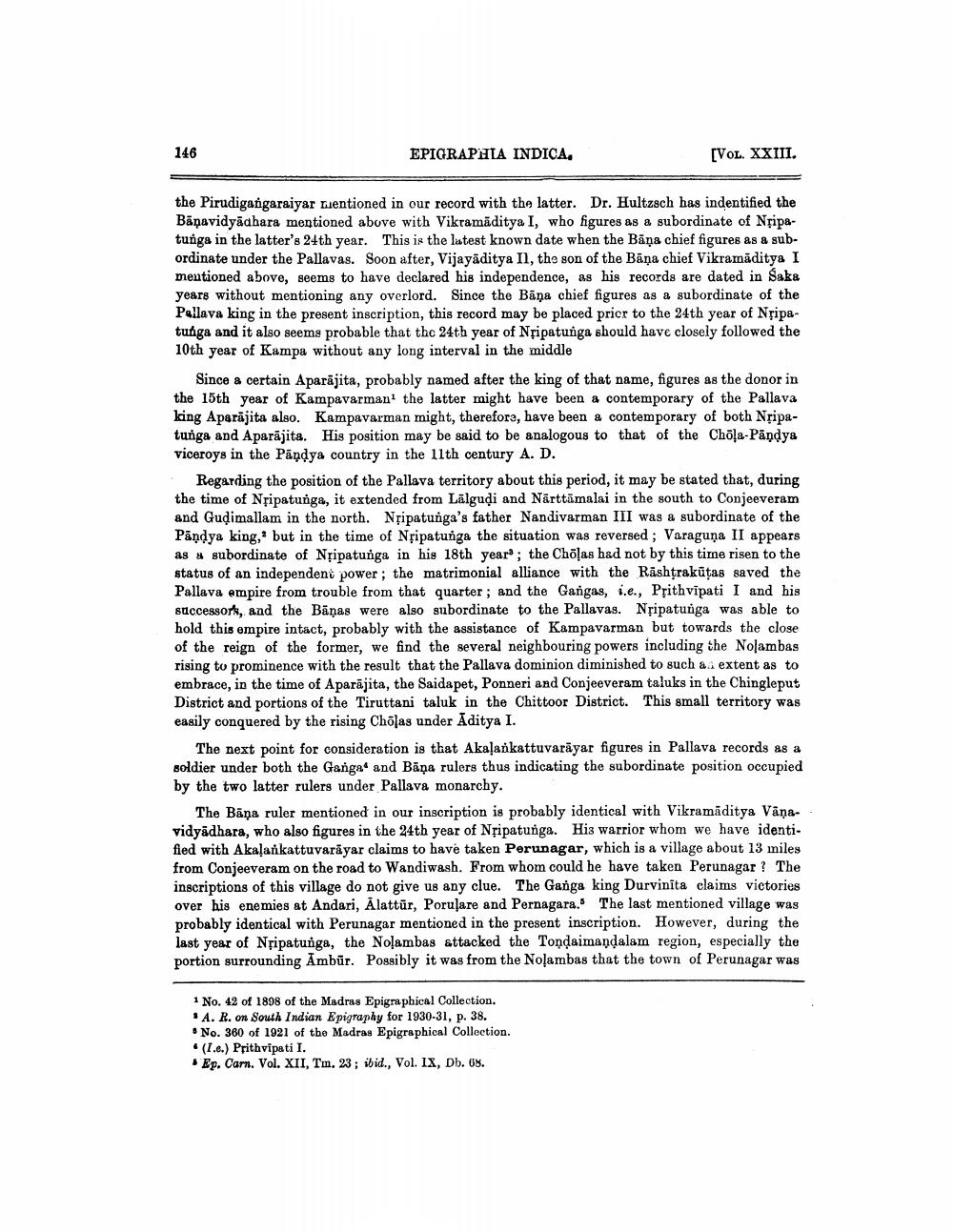________________
146
EPIGRAPHIA INDICA,
[VOL. XXIII.
the Pirudigangaraiyar mentioned in our record with the latter. Dr. Hultzsch has indentified the Bāņavidyādhara mentioned above with Vikramāditya I, who figures as a subordinate of Nřipatunga in the latter's 24th year. This is the latest known date when the Bāņa chief figures as a subordinate under the Pallavas. Soon after, Vijayāditya Il, the son of the Bāņa chief Vikramaditya I mentioned above, seems to have declared his independence, as his records are dated in Saka years without mentioning any overlord. Since the Bāņa chief figures as a subordinate of the Pellava king in the present inscription, this record may be placed prior to the 24th year of Nřipatunga and it also seems probable that the 24th year of Nřipatunga should have closely followed the 10th year of Kampa without any long interval in the middle
Since a certain Aparājita, probably named after the king of that name, figures as the donor in the 15th year of Kampavarman' the latter might have been a contemporary of the Pallava king Aparajita also. Kampavarman might, therefore, have been a contemporary of both Nřipatunga and Aparajita. His position may be said to be analogous to that of the Chola-Pāndya viceroys in the Pandya country in the 11th century A. D.
Regarding the position of the Pallava territory about this period, it may be stated that, during the time of Nřipatunga, it extended from Lālguļi and Nārttāmalai in the south to Conjeeveram and Gudimallam in the north. Nřipatunga's father Nandivarman III was a subordinate of the Pāņdya king, but in the time of Nộipatunga the situation was reversed; Varaguņa II appears as # subordinate of Nțipatunga in his 18th years; the Chēļas had not by this time risen to the status of an independent power; the matrimonial alliance with the Rashtrakūtas saved the Pallava empire from trouble from that quarter; and the Gangas, i.e., Prithvipati I and his successork, and the Bānas were also subordinate to the Pallavas. Nřipatunga was able to hold this empire intact, probably with the assistance of Kampavarman but towards the close of the reign of the former, we find the several neighbouring powers including the Nolambas rising to prominence with the result that the Pallava dominion diminished to such a, extent as to embrace, in the time of Aparajita, the Saida pet, Ponneri and Conjeeveram taluks in the Chingleput District and portions of the Tiruttani taluk in the Chittoor District. This small territory was easily conquered by the rising Cholas under Aditya I.
The next point for consideration is that Akalankattuvarāyar figures in Pallava records as a soldier under both the Ganga and Bāņa rulers thus indicating the subordinate position occupied by the two latter rulers under Pallava monarchy.
The Bāna ruler mentioned in our inscription is probably identical with Vikramaditya Vanavidyadhara, who also figures in the 24th year of Nřipatunga. His warrior whom we have identified with Akaļankattuvarāyar claims to have taken Perunagar, which is a village about 13 miles from Conjeeveram on the road to Wandiwash. From whom could he have taken Perunagar? The inscriptions of this village do not give us any clue. The Ganga king Durvinita claims victories over his enemies at Andari, Alattūr, Porulare and Pernagara. The last mentioned village was probably identical with Perunagar mentioned in the present inscription. However, during the last year of Nřipatunga, the Nolambas attacked the Tondaimandalam region, especially the portion surrounding Ambür. Possibly it was from the Nolambas that the town of Perunagar was
1 No. 42 of 1898 of the Madras Epigraphical Collection. *A. R. on South Indian Epigraphy for 1930-31, p. 38. • No. 360 of 1921 of the Madras Epigraphical Collection. (1.e.) Prithvipati I. Ep. Carn. Vol. XII, Tm. 23; ibid., Vol. IX, Db. 68.




